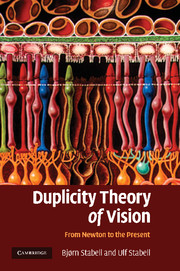Book contents
- Frontmatter
- Contents
- Acknowledgements
- 1 Introduction
- Part I The development of the basic ideas of the duplicity theory from Newton to G. E. Müller
- Part II The development of the duplicity theory from 1930–1966
- Part III Chromatic rod vision: a historical account
- Part IV Theories of sensitivity regulation of the rod and cone systems: a historical account
- 15 Introduction
- 16 Early photochemical explanations
- 17 Contribution of S. Hecht
- 18 Contribution of G. Wald: photochemical sensitivity regulation mechanisms of rods and cones
- 19 Relationship between amount of rhodopsin and sensitivity during dark adaptation
- 20 Post-receptor sensitivity regulation mechanisms
- 21 Rushton's AGC model
- 22 Contribution of H.B. Barlow
- 23 Rushton and Barlow compared
- 24 The Dowling-Rushton equation refuted
- 25 Several mechanisms involved in sensitivity regulation
- 26 Sensitivity regulation due to rod-cone interaction
- 27 Modern conceptions of sensitivity regulation
- Part V Factors that triggered the paradigm shifts in the development of the duplicity theory
- References
- Index
27 - Modern conceptions of sensitivity regulation
Published online by Cambridge University Press: 22 January 2010
- Frontmatter
- Contents
- Acknowledgements
- 1 Introduction
- Part I The development of the basic ideas of the duplicity theory from Newton to G. E. Müller
- Part II The development of the duplicity theory from 1930–1966
- Part III Chromatic rod vision: a historical account
- Part IV Theories of sensitivity regulation of the rod and cone systems: a historical account
- 15 Introduction
- 16 Early photochemical explanations
- 17 Contribution of S. Hecht
- 18 Contribution of G. Wald: photochemical sensitivity regulation mechanisms of rods and cones
- 19 Relationship between amount of rhodopsin and sensitivity during dark adaptation
- 20 Post-receptor sensitivity regulation mechanisms
- 21 Rushton's AGC model
- 22 Contribution of H.B. Barlow
- 23 Rushton and Barlow compared
- 24 The Dowling-Rushton equation refuted
- 25 Several mechanisms involved in sensitivity regulation
- 26 Sensitivity regulation due to rod-cone interaction
- 27 Modern conceptions of sensitivity regulation
- Part V Factors that triggered the paradigm shifts in the development of the duplicity theory
- References
- Index
Summary
During the last two decades the presumption that sensitivity regulation is basically controlled by photochemical processes located in the outer segment of the receptors has been replaced by much more complex theoretical conceptions. A recent review paper on gain controls in the retina by Dunn and Rieke (2006) gives an excellent illustration of this development. The authors argue that there are multiple retinal gain controls (i.e. adaptation mechanisms) that adjust sensitivity to different aspects of the light stimulus such as changes in mean intensity, variability about the mean (i.e. contrast variability) and spectral composition, and that the gain controls have diverse temporal and spatial properties, serve different functional roles and are located at different sites in the retina. Indeed, an additional dimension of complexity is introduced in that the gain controls are assumed to interact with other computations carried out in the retinal pathways.
In support of their suggestion that gain controls of the cone system may operate at different sites in the retina, they present evidence that both small and large steps in mean intensity and contrast may alter the gain adaptation level of ganglion cells, while only large steps change the gain of the receptors. Strong support in favour of the suggestion that gain controls may operate at different sites had previously been provided by Ahn and MacLeod (1993) and Yeh et al. (1996).
- Type
- Chapter
- Information
- Duplicity Theory of VisionFrom Newton to the Present, pp. 192 - 194Publisher: Cambridge University PressPrint publication year: 2009



